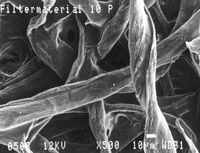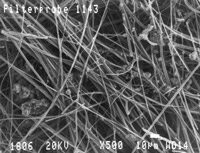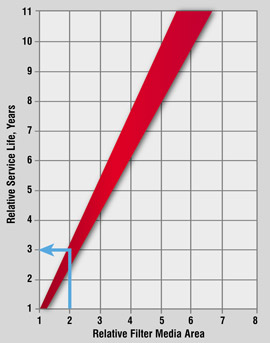The enemy of any lubricated machine is particle contamination.In a perfect world, machines would be sealed up to block the ingression of particles before any problems occur, but unfortunately, this isn’t the case — we live in a dirty environment.
Particles exist everywhere, and lubricated components are constantly under attack from them. Whether the particles are ingested by poor-quality breathers or dirty oil from a recent top-up, the question of what can be done to get rid of them remains. The obvious solution is filtration.
Filters can extend the life of machines by removing harmful particles before they can cause surface degradation of the lubricated components. There are two common types of filters: surface or membrane filters and depth filters.
Surface filters simply trap particles on the surface or face of the filter. Depth filters allow the oil to flow throughout the body or depth of the filter and trap particles throughout the media. Perhaps the most crucial attribute of any filter is the ability to trap and hold dirt.
This differential pressure can lead to a condition in which the filter’s bypass or cracking pressure is reached, allowing oil to flow through virtually unfiltered. Additionally, if the pressure becomes too great, it can cause the actual filter media to burst.Each filter has a specific pore size — this is the size of the openings within the media through which the oil and particles can pass. As the pore size gets smaller and smaller, the differential pressure across the media increases.
Once particles are captured, it becomes a measure of how well the filter can retain them — this is known as the filter’s dirt holding capacity. Several factors contribute to how well filters hold the contaminants they catch. We’ve discussed the pore size of the filters, but pore density is equally important.
Pore density can be described as the number of pores in a section of the filter. This is also known as the porosity of the filter. As pore size goes down, to maintain a low differential pressure across the media, the pore density must go up to account for the volume of oil in contact with the surface. Thus, filter depth and size also affect the dirt-holding capacity.

Cellulose (Wood Pulp) Filter Media
Another thing to keep in mind when selecting filters is the material the media is composed of. This has an effect on the longevity of the filter, its adaptability to its environment, and its dirt-holding capacity. Two common types of filter media are cellulose (which is comprised of wood) and synthetics.
Cellulose filter media has a large fiber size and a less consistent pore size throughout the entire filter. Cellulose has the advantage of being able to absorb some water from the oil it is filtering. However, cellulose filters tend to fail quicker in acidic environments and high-temperature applications.
Synthetic filter media generally have a higher dirt-holding capacity than cellulose, in part due to the more consistent pore size throughout the media.
Synthetic fibers are smaller than cellulose fibers, so they can be packed tightly together, creating more pores in which to trap and hold particles. Synthetic fibers also perform better in harsh environments that tend to destroy cellulose filters.

Fiberglass Filter Media
In examining the technical sheets of filters, you may have seen a filter’s beta rating— this describes how efficient the filter is at removing particles.

TTI's PowerGuard Elements use a synthetic microglass media to capture particles
You may also have seen a value for the dirt-holding capacity. This value is obtained through a test known as ISO 16889 or the multi-pass test. In this standard test, a filter is put into a circuit that is filled with oil. The oil circulates through the filter, then a set amount of sized particles is released into the oil to test the filter’s ability to capture them.
A particle counter before and after the filter measures the difference in particles. The results of this test will allow you to see how well or poorly a filter performs against different particle sizes.
Keep these things in mind when selecting the next filter to clean your oil and protect your expensive machinery. Check the filter’s beta rating and pore size. Obviously, there is a big difference between a 40-micron filter and a 3-micron filter when you are talking about the size of particles allowed downstream.
Also, whenever available, verify the results of the ISO 16889 multi-pass test. This will not only show you the efficiency of the filter but also how well it can retain the particles it removes from the circulating oil.

Fiberglass vs. Cellulose
Some filter manufacturers don’t show the results of this test as it pertains to the dirt-holding capacity of the filter, but by pressuring them and demanding to see the results, you can make the best decision for you and your machines.
If they balk at the idea of providing the test results, there are labs across the country that can run the ISO 16889 test on the filter to give you the results. This is more expensive for the end-user, but it offers the peace of mind that you have the right filters for your applications.
Prolonging Filter Service Life
Selecting the proper filter with a high dirt-holding capacity is only half the battle. You also must ensure these filters are put into use the right way. Filters can be expensive, so naturally, you want to prolong the life of the filter to cut down on the costs associated with changing them.

Double the size of the filter and you can triple the service life (dirt-holding capacity). Reference Pall Corporation
One of the easiest ways to prolong the filter change-out interval is by oversizing the filter. As you can see in the chart above, by doubling the surface area of a filter, you can expect three times the life from it.
There are different methods of oversizing filters. The most obvious is by increasing the physical size of the filters you are using. This is somewhat costly, as equipment modification is required to fit a larger filter in the lines. For some equipment where space is limited, this may not even be feasible. That is when you should start looking at putting filters in parallel.
By placing multiple filters in parallel, you double the surface area in contact with the oil, thereby reducing the face velocity (the pressure of the oil on the surface of the filter media) and extending the life of the filter — this means fewer filter changes and the ability to capture more particles between change-outs.
If the equipment doesn’t permit the extra piping needed to put in a parallel circuit, there are systems that stack filters one on top of another to increase the overall length of the media, again allowing for the decrease in pressure the media is experiencing.


.jpeg)

